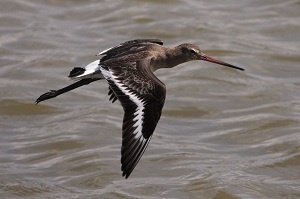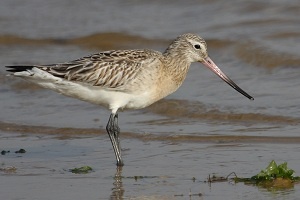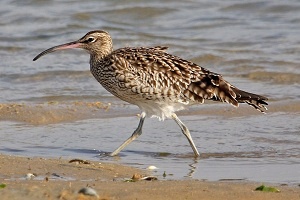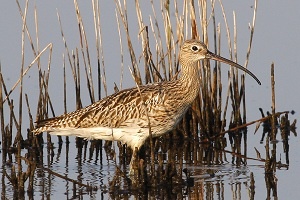Black-tailed Godwit🠉
Limosa limosa

Fairly large-sized wader (37 to 42 cm), quite long-legged, with a long straight bill. Can be confused with the Bar-tailed Godwit, but differs in its slightly longer straighter bill and longer tibiae. Distinctive plumage in flight: broad white wingbar, black tail, and white square on the rump. Characteristic elongated shape. The plumage is orange-brown, with a whitish belly and undertail in breeding birds. They also show coarse transverse markings on the flanks.
In non-breeding plumage, the chest and upperparts are uniformly pale grey-brown.
The juveniles have orange-buff tones on the neck and chest, coarsely spotted upperparts, and neat pale edges to the tertials. The legs are black.
Call: rapid, plaintive “vi-vi-veh”, and “veh-i” recalling the Northern Lapwing.
L. 37-42 cm ; W. 63-74 cm.
Similar species: Bar-tailed Godwit.
©Thomas Galewski
Bar-tailed Godwit🠉
Limosa lapponica

Similar in size to the Black-tailed Godwit (35-41 cm), but differs in its shorter legs (tibiae). The bill is also shorter and fairly obviously upcurved (difference in bill length depending on sex, the females having longer bills). In flight, the legs barely reach beyond the tail (markedly in the Black-tailed Godwit), the tail is barred, a wide, pointed dorsal patch is visible (as in curlews), and there is no wingbar.
Males in breeding plumage are brick-red below. The female is paler: dirty white tinged with orange, and with a streaked chest. The bill is black (has a broad orange basal half in the Black-tailed Godwit). The adult in non-breeding plumage looks pale brownish-grey above with black centres to the feathers, giving the bird a streaked appearance. The underparts are dirty white. The bill, as in the juvenile, is pale with a dark tip.
The juvenile plumage is like that of adults in winter but darker, with jagged outlines to the pale edgings on the scapulars and tertials. The chest is all streaked.
Call: nasal “kuvi-kuvi “.
L. 35-41 cm ; W. 62-72 cm.
Similar species: Black-tailed Godwit.
©Thomas Galewski
Whimbrel🠉
Numenius phaeopus

Similar to the Eurasian Curlew, but slightly smaller, the bill is a little shorter and it shows a conspicuous central pale stripe on the crown, bordered with dark. The eye stripe is also darker than in the related species.
In flight, appears slightly darker than the Eurasian Curlew, and the wingbeats are faster.
Call: rapid “fi-fi-fi-fi-fi”.
L. 37-45 cm ; W. 78-88 cm.
Similar species: Eurasian Curlew.
©Thomas Galewski
Slender-billed Curlew🠉
Numenius tenuirostris

Markedly smaller than the Eurasian Curlew, of similar size to the Whimbrel, but slimmer. Bill straighter and thinner at the tip. Compared with the other two curlews, whiter on the sides of the head, the throat, and chest. The dark marks on the underparts contrast more. Lores relatively dark, contrasting with a rather pale supercilium. Underwing coverts all white contrasting with a darker outer wing (the primaries being entirely dark). Rump white and upper tail very pale. Secondaries and inner primaries clearly marked with white, contrasting with the dark outer primaries. The adult shows drop-shaped spots on the underparts, while the juvenile is streaked below.
Voice: call similar to Eurasian Curlew, “kou-li”, but softer and faster.
L. 36-41 cm ; W. 77-88 cm.
Similar species: Eurasian Curlew, Whimbrel.
Eurasian Curlew🠉
Numenius arquata

The largest of our waders, easily recognised by its long, thin, downcurved bill. The plumage is brown/grey on the back, and it has a white belly streaked with brown/grey. Its legs are long, grey/blue in colour. Its flight is slow and a broad, pointed white dorsal patch can be seen, as well as dark primaries contrasting with the rest of the wing, which is brown/grey.
Its call, “kuuur-li” is loud, fluting and rising. It also gives “kuui-kui-kuh” calls.
It is usually found in flocks.
L. 48-57 cm ; W. 89-106 cm.
Similar species: Whimbrel.
©Marc Thibault




.png)
